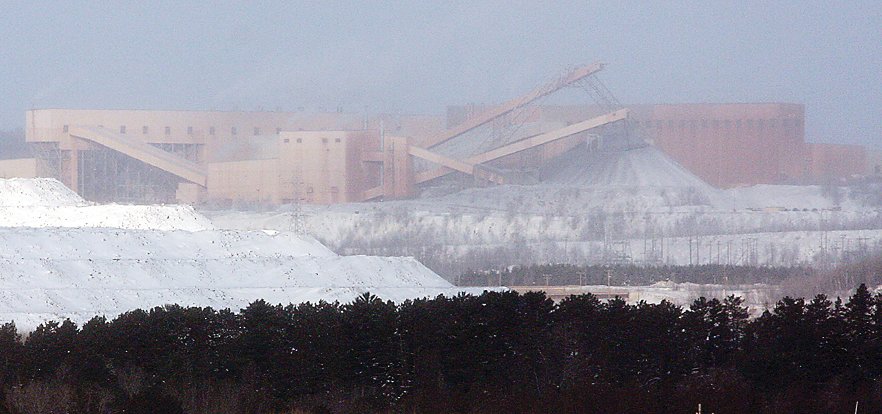Support the Timberjay by making a donation.
More legal setbacks for U.S. Steel and Minntac
REGIONAL— U.S. Steel’s legal options for avoiding regulation of sulfate pollution the company discharges from its Minntac tailings basin may have finally been exhausted following a …
This item is available in full to subscribers.
Attention subscribers
To continue reading, you will need to either log in to your subscriber account, below, or purchase a new subscription.
Please log in to continue |
More legal setbacks for U.S. Steel and Minntac
REGIONAL— U.S. Steel’s legal options for avoiding regulation of sulfate pollution the company discharges from its Minntac tailings basin may have finally been exhausted following a decision issued Monday by the Minnesota Court of Appeals. In it, the appellate court found that U.S. Steel has no right to a variance from the 357 milligrams per liter (mg/l) sulfate limit established in a 2018 water discharge permit issued by the state’s Pollution Control Agency, nor does the company have a basis for seeking a contested case hearing over the sulfate limit.
That would appear to close the door to further court delays by the company, which the MPCA has accused of deploying foot-dragging tactics for years in an effort to avoid a clean-up of its sulfate-tainted tailings basin water.
The latest decision came after the third go-round in court. The Supreme Court had remanded three issues back to the Court of Appeals, after the high court had ruled largely against U.S. Steel’s claims earlier this year. The appellate court, in turn, ruled against U.S. Steel on all three of the remaining issues.
“I think this is really good news,” said Paula Maccabee, legal counsel for Duluth-based Water Legacy, which has pushed in the courts for years to address Minntac’s discharges.
The 8,000-acre basin, located just north of Virginia, discharges millions of gallons a day of contaminated water into the Dark River and the Sand River, which is a tributary to the Pike River and Lake Vermilion. Sulfate pollution is linked to the reduction of wild rice and is also known to facilitate the uptake of mercury into the aquatic food chain.
U.S. Steel had sought to eliminate the sulfate limit in its permit, which would require the company to cut the sulfate level in its tailings basin water by about two-thirds. A U.S. Steel-commissioned study conducted several years ago had determined that the company could meet a 250 mg/l federal sulfate limit in groundwater below the tailings basin by lowering its sulfate level in the basin water to 357 mg/l. Currently, sulfate levels in the basin are around 1,000 mg/l and the company contends that reducing sulfate levels by two-thirds isn’t economically feasible.
U.S. Steel had wanted a contested case hearing to challenge the findings of the study, yet the court noted that it was U.S. Steel’s own consultant who had done the analysis and that the company had presented no evidence that countered the findings of its own study. “On this record, the MPCA properly denied U.S. Steel’s request for a contested-case hearing,” wrote the court in its ruling this week.
The court was equally dismissive of the company’s challenge of the MPCA’s decision to deny a variance from the sulfate limit in the tailings basin. While the company argued that requiring sulfate reductions would present an “undue hardship” on the company, the court found that U.S. Steel “has not argued, much less substantiated with the required information,” that it would be unduly harmed by the requirement to invest in clean-up.
The court also reiterated its previous finding that the MPCA had erred when it failed to include water quality-based effluent limits, or WQBELs, in the new Minntac permit. That means the MPCA will need to provide better rationale for how its failure to set pollution limits for Minntac complies with the federal Clean Water Act, or the agency will need to incorporate limits into the permit.
And, finally, the appellate court, as directed by the Supreme Court, remanded the Minntac permit to the MPCA to determine whether groundwater seepage from under the Minntac basin’s dikes is the “functional equivalent” of a direct discharge.
The MPCA had determined that those discharges weren’t subject to regulation under the Clean Water Act, but a recent U.S. Supreme Court ruling in County of Maui v. Hawaii Wildlife Fund, determined that the Clean Water Act does apply to pollution discharged through groundwater if it is the “functional equivalent” of a direct surface discharge. The MPCA will now need to determine whether the Minntac discharges meet that definition.
Maccabee had predicted the Maui decision could have major repercussions for mine tailings basins in the state by upsetting what she views as a longstanding agreement between the MPCA and the mining industry. “They’ve had a quiet agreement for years that they wouldn’t regulate seepage through groundwater,” said Maccabee. “Now, this likely reverses that.”






